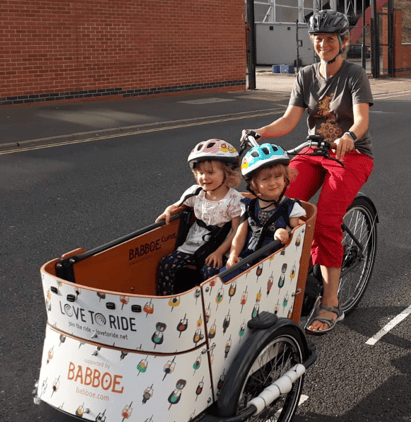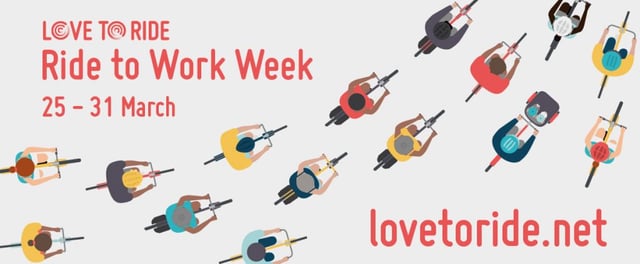If you cycle occasionally for fun or fitness, then this post is to help you to take the next step and get happier, healthier and wealthier by commuting to work by bike. It will help you to identify the barriers to cycling to work and give you some basic, practical steps towards overcoming them. But let's start by looking at the benefits.
Why cycle?
You'll be happier. Cycling is proven to improve mental health, having a positive effect on wellbeing, self-confidence and resistance to stress. It also helps to reduce tiredness and difficulties sleeping.* People who have switched to commuting by bike consistently report an improved sense of happiness and wellbeing.
You'll be healthier. Cycling is fantastic exercise. It helps you to lose weight and build muscle without putting too much strain on your joints. A major study at the University of Glasgow recently found that 'commuters who cycled were associated with a 41% lower risk of premature death' and '45% lower risk of developing cancer and a 46% lower risk of heart disease'.* Quite simply, riding to work could save your life.
You'll be wealthier. Love to Ride participant (and 2018 Global Prize Winner!) Andy King saved £3,000 a year by switching to the bike for his commute. He also saves thirty minutes a day.
You can win awesome prizes. We're going Dutch for Ride to Work Week, so you can win a Babboe cargo bike or a trip for two to the Netherlands just for riding all or part of the way to work from 25-31 March! We're also giving away amazing Loffi gloves and lots of other goodies...

Know Your Route
Whether you currently drive, walk, or use public transport to get to work, the chances are the best route to take by bike won't be the one you take now. There are fantastic online resources for sniffing out two-wheeled tricks to avoid traffic and get you to work as fresh and stress-free as possible, such as Cyclestreets (which also has an excellent app) and Google Maps. There’s no substitute, though, for first-hand knowledge and experience: talk to regular cycle commuters, ask them for tips on where to go and tricks to avoid the worst traffic black spots.
Once you’ve got a good idea of the best route to take, do as much of a recce as you can, preferably when there’s not too much traffic around. If you know the road layout ahead, it’s easier to ride confidently in heavy traffic or bad weather when you’re on your way to work.
Confidence
Even the most careful route planning sometimes can’t entirely avoid busy rush-hour traffic and for many people the greatest obstacle to commuting by bike is an understandable reluctance to mix it with buses, cars and lorries. Here are two straightforward steps to help boost your cycling confidence and equip you with the necessary skills to deal with busy sections of your commute:
Find out about expert training in your area. You wouldn’t drive a car to work before your first driving lesson and unless you’re a confident and experienced road user you shouldn’t cycle to work without some basic training either. Adult cycle training is offered for free or at heavily subsidised rates by most local authorities. You can book a session to ride to work with your instructor and talk over any difficult junctions or traffic black spots so you have specific guidance tailored to your own commute. We can't recommend training from a qualified National Standards Instructor (NSI) highly enough - find your local provider here.
Team up with a colleague or a neighbour. If you know someone who works with or near you and cycles to work, ask if you can meet them and ride in together a few times. Even the busiest and most daunting commute will feel much more achievable if you can tuck in behind an experienced cyclist, follow their line and learn their tricks for dealing with busy junctions or confusing roundabouts. Most cycle commuters are enthusiastic about cycling and will be glad to help someone make the transition to commuting by bike.
Equipment
Unless your commute is a substantial distance or over tricky terrain, you don’t need to spend a fortune on a high-end bike and fancy clothing and accessories. However, if you are going to ride to work every day it is worth making sure you can commute comfortably and carry the necessary luggage. If you don’t have a bike or there’s only a rusting death-trap in the garden shed, then consider borrowing or hiring one for a week to see how you find it (schemes such as Cycle Boost in South Yorkshire offer free 1-month loans so you can try riding to work without having to buy a bike; see if there is a similar service in your area). If you live near a Brompton Dock or there's a bike share scheme where you live you can try cycling to work a few times for less than £20.Increasingly bike shops are offering good, well-equipped bikes for short-term hire at reasonable prices. If you decide cycling to work is for you, look into Cyclescheme: if your employer is signed up you can make substantial savings on new bikes and equipment.
Increasingly, people are disocvering the benefits of e-bikes for commuting. They flatten the hills and mean you turn up feeling fresh, plus they make commuting by bike a piece of cake for anyone who feels they don't have the fitness to start riding to work on a conventional bike straight away. E-bikes are getting better and cheaper as they become more widespread, so ask your local bike shop for advice.
Other than a bike, you don’t need to worry too much: the majority of people who cycle to work do so in their work clothes. If you want to ride to work whatever the weather or if you have a demanding route, water-proof panniers and/or a change of clothes at work might help: through trial and error you’ll quickly work out the routine and equipment that suit you best. The only ‘must’ is to make sure you have a good lock: the police recommend spending at least a tenth of the value of your bike on a lock.

Your Employer
Your workplace might already have secure bike storage, cycle showers and lockers: sometimes facilities for people who ride to work are tucked away and not very well advertised, so it’s worth asking around to see what’s available. If there aren’t any facilities for cycle commuters, persuade them that there should be. They might not be aware of the benefits of a two-wheeled workforce: research suggests that cycling to work can halve sick days and happier and healthier employees are more productive and highly motivated.** Plus encouraging cycling is a must for any organisation – and it should be every one – that cares about the environment and its green credentials. So if there are no facilities ask your employer why and persuade them that installing a shower and some secure bike storage will be worth their while. Oh, and tell them about the benefits of Love to Ride!
Enjoy!
If you follow these simple suggestions, overcoming the barriers you face to cycling to work won't be a big deal. Once you’ve got hold of a bike, worked out your route and got expert advice you can take the plunge and cycle into work a few times. You'll quickly start to enjoy it and feel the benefits and hopefully you’ll stick at it and in a year or two you’ll struggle to remember how – or why – you ever travelled to work any other way. Surely there's no better way to get happier, healthier and wealthier than simply by changing your traveling routine: it's as easy as riding a bike.
* https://www.gla.ac.uk/news/archiveofnews/2017/may/headline_522765_en.html
** https://www.sustrans.org.uk/blog/why-walking-and-cycling-are-good-business - if there aren't facilities at your work, it's a good idea to see if there's a gym or leisure centre nearby where you can get a cheap membership just to use the shower and changing facilities
Already ride to work? Check out this great post by Cyclescheme: 10 Ways to Encourage People to Cycle to Work
Privacy policy
All rights reserved. Copyright 2021